|
DURABOOK Z14I
Durabook's powerful new fully-rugged laptop takes on the established competition with a thoroughly modern design, impressive build and protection, and vast built-in customization potential. (by Conrad H. Blickenstorfer; photography by Carol Cotton)
Share on:



In this article we're examining Durabook's newest fully-rugged notebook computer, the DURABOOK Z14I. The heavily fortified laptop was introduced on July 30, 2019 by the well-established company as a mobile computer "engineered for the extreme conditions faced by military and field service personnel around the globe." Durabook also pointed out an "unprecedented range of built-in customization possibilities," something that's crucial to cover the vast range of customer requirements in this market.
With the new super-duty Z14I, Durabook clearly aims to take on the heavyweights in the "fully-rugged" class, the Getac B300, Panasonic Toughbook 31, and Latitude 7424 Rugged, all targeted at customers who need more durability and substantially more ruggedness than any standard consumer notebooks can provide.
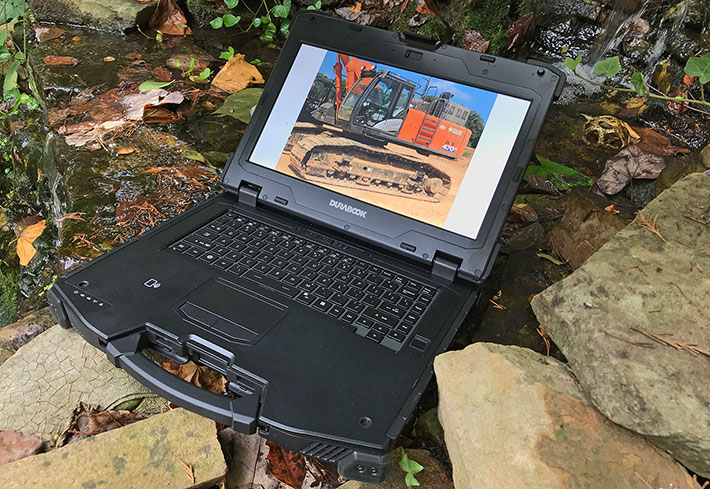
Durabook Americas, the North American subsidiary of Twinhead and formerly known as GammaTech, has been in this market for decades (see GammaTech celebrates its 30th anniversary], specializing in industrial and application specific/mission critical systems tough enough for a wide range of applications and environments.
Where do heavy-duty laptops like this DURABOOK fit in and what can they do? In essence, there are four classes of laptops. Standard consumer laptops are built for use at home, in the office, and perhaps on a business trip or two. "Semi-rugged" laptops are built to handle a variety of conditions ranging from mild (like in a field office) to fairly demanding (like in a vehicle). Beyond that it's either fully-rugged designs like the DURABOOK Z14I or, at a much higher price, dedicated military gear.
But doesn't Durabook already have that covered with their existing DURABOOK R8300? It does, but while the R8300 has been kept technologically up-to-date, it is an older design representing a class of machines that goes back a quarter of a century when pioneering computer makers began beefing up standard notebook computers to make them more suitable for work in the field. The DURABOOK Z14I, on the other hand, is all state-of-the-art. Durabook president Joe Guest describes the new machine as "an example of our commitment to innovation," a purpose-built rugged laptop with "Proprietary technology, unprecedented I/O port offering and boundless customization options."
The DURABOOK Z14I — overview
The DURABOOK Z14I is a full-size notebook with a 14.0-inch wide-format screen. It measures 14.0 x 11.0 (plus another inch and a half for the handle) x 2.0 inches, and our nicely equipped review unit weighed in at a not unsubstantial 8.75 pounds. That's a good deal thicker and heavier than a standard consumer notebook, but about par for the fully-rugged class, and downright sleek by military gear standards. While early DURABOOK laptops often had a simple and kind of generic look to them, the Z14I conveys toughness, purpose, and understated elegance all at once.
The table below shows Durabook's current (as of late 2019) lineup of fully-rugged (the Z14I and R8300) and semi-rugged (the Z14I, SA14, and A15AB) laptops. Note the fairly significant price differences between fully-rugged and semi-rugged models.
|
DURABOOK rugged and semi-rugged laptop lineup
|
|
|

|

|

|

|

|
|
DURABOOK model
|
Z14I
|
R8300
|
S14I
|
S15AB
|
SA14
|
|
First introduced
|
2019
|
2014
|
2018
|
2015
|
2013
|
|
Ruggedness
|
fully-rugged
|
fully-rugged
|
semi-rugged
|
semi-rugged
|
semi-rugged
|
|
Size (inches)
|
14.0 x 11.0 x 2.0
|
12.0 x 11.6 x 2.4
|
13.8 x 11.1 x 1.5
|
14.7 x 10.7 x 1.1
|
13.5 x 9.7 x 1.9
|
|
Volume (cubic inches)
|
308
|
334
|
230
|
173
|
249
|
|
Weight
|
7.9 lb
|
7.9 lb
|
5.1 lb
|
5.7 lb
|
7.8 lb
|
|
Intel Processor
|
Kaby Lake R (G8)
|
Kaby Lake (G7)
|
Kaby Lake R (G8)
|
Broadwell (G5)
|
Kaby Lake (G7)
|
|
Thermal Design Power
|
15 watts
|
15 watts
|
15 watts
|
15 watts
|
15 watts
|
|
Display size (inches)
|
14.0 (1920 x 1080)
|
13.3 (1024 768)
|
14.0 (1920 x 1080)
|
15.6 (1920 x 1080)
|
14.0 (1366 x 768)
|
|
Primary Battery capacity
|
84 watt-hours
|
86 watt-hours
|
51 watt-hours
|
59 watt-hours
|
87 watt-hours
|
|
Std. battery life
|
15 hrs.
|
14 hrs.
|
8.5 hrs.
|
14 hrs.
|
12 hrs.
|
|
Drop spec
|
6.0 feet
|
4.0 feet
|
4.0 feet
|
2.5 feet
|
3.0 feet
|
|
Sealing
|
IP65
|
IP65
|
IP53
|
IP5x
|
IP53
|
|
Starting price
|
US$3,599
|
US$3,199
|
US$1,849
|
US$1,999
|
US$1,499
|
As far as the new DURABOOK Z14I goes, all the conveniences and features of a consumer notebook are there: a clean, logical full-size keyboard, up to a terabyte of either hard or solid state disk (and more with an optional secondary drive), room for a Super Multi DVD drive if so desired, a wealth of card readers (microSD Card, Smart Card, SIM, ExpressCard or PC Card), enough memory (up to 32GB of state-of-the-art DDR4), and plenty of onboard connectivity both wired and wireless.
Durabook has a history of making sure to always offer customers the latest available Intel processors. That's not always possible, given Intel's rapid-fire release of new generations. As is, the DURABOOK Z14I comes with the choice of one of four Intel 8th generation Core i5 and i7 CPUs. Our review unit was equipped with a Core i7-8550U quad-core vPro processor.
The DURABOOK Z14I uses heavy-duty aluminum-magnesium for chassis and part of the exterior, very solid display hinges, and a fully integrated carry-handle. It feels way more solid than any semi-rugged, let alone any consumer laptop. All ports and slots are behind protective doors. Unlike semi-ruggeds, the Z14I is pretty much a fully sealed machine. It can handle far more than just the spills and rain which are semi-rugged designs' limit. And unlike in semi-rugged designs, there are no ventilation slots and other unsealed openings. That means no noisy fan that might fail or leak. That's what fully-rugged means, superior protection and virtually total immunity to the elements.
Design, look, and feel — purposeful and remarkably elegant
The product photography compilation below shows the DURABOOK Z14I from the top and all four sides. It's an undeniably attractive design that looks good on pictures and even better in person. The strong aluminum-magnesium alloy chassis and bottom mean the computer doesn't creak and twist like most plastic-based consumer laptops. The body of the Z14I is black, the top of the LCD case is a dark matte silver-gray with a powder-coat finish, black accents, and a designated logo area (Durabook machines often sell in rebadged versions). The top of the LCD case is contoured to add extra stiffness.
Much like the semi-rugged S14I model, the fully-rugged Z14I perfectly projects the tough tool-for-the-job look common to most heavy-duty rugged notebooks. The strong LCD hinges offer good resistance when opening and closing the computer. When closing the laptop, a spring-loaded latch snaps into place, securing the LCD when in closed position. To open the notebook again, you push a spring-loaded lock.
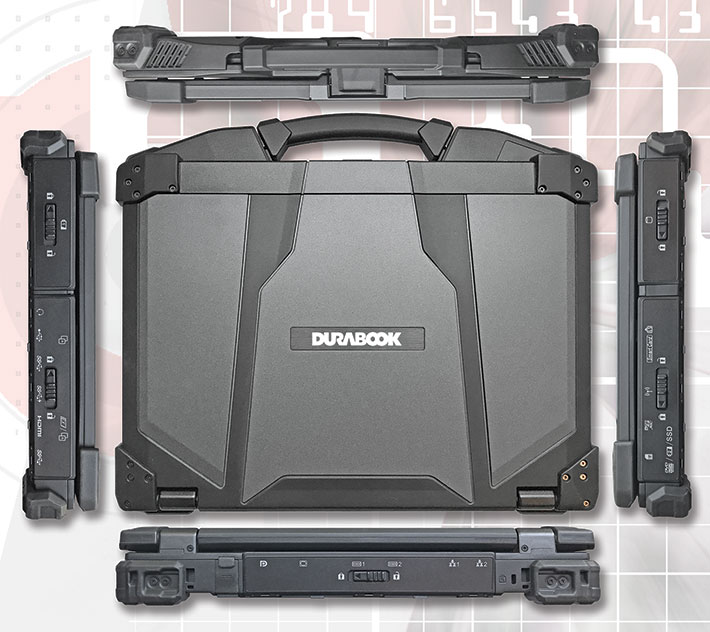
Ports and connectivity are placed on the left, right and back sides of the laptop. The ports on each side are located behind hinged plastic covers with sliding locks that protect against physical damage and are also designed to provide full protection against dust and liquids. All covers are screwed on and, if need be, replaceable.
The two pictures below show a more detailed view of the left and right side of the DURABOOK Z14I.
On the right side (top picture), from left to right, first is the compartment for the main battery. To the right of that is a large double-decker I/O area that on the upper level has two card slots (in our unit a PC Card Type II and an ExpressCard slot); and on the lower level an audio combo jack, a USB 2.0 Type A port, two USB 3.1 Type A ports (one of them supports charging even when the computer is off), an HDMI port, and a reversible USB Type C port.
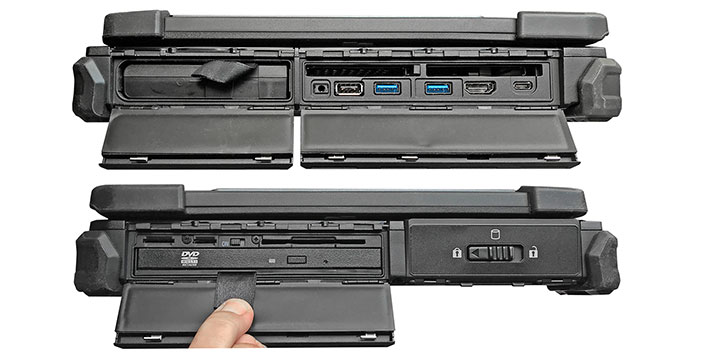
On the left side is the storage drive compartment that holds the quick-release hard disk or solid state disk caddy. Next to it another large double-decker I/O area with, on top from left to right, a SIM card slot, a microSD card slot, a slider that turns all radios on or off, and a Smart Card reader. Below that is a bay that can accommodate either an optical disk drive, a secondary battery pack, or a secondary storage caddy.
On the back of the machine is the power jack, then another large I/O area with, again from left to right, a DisplayPort jack, a VGA port, two legacy DB9 RS232 serial ports, and two RJ45 LAN jacks. Next to that is a Kensington-compatible physical lock slot. Yes, physical security remains important.

Below is what the DURABOOK Z14I looks like from the bottom. On the left is the unit fully assembled. Note the substantial rubber corner guards that provide protection and also a sure footing for the laptop. There is a grand total of eight of them, each screwed on and easily replaceable. On the right is a look at the underside of the Z14I with its bottom corner guards removed abd its three major I/O compartment doors open. Note how each port is clearly labeled with white-on-black description or icon.
What you don't see are access doors to module (i.e. RAM, WWAN, WLAN, GPS, storage, etc.) compartments. There aren't any. Those modules are accessed from the top instead. That way those modules can be accessed even when the Z14I is bolted onto its optional expansion chassis.
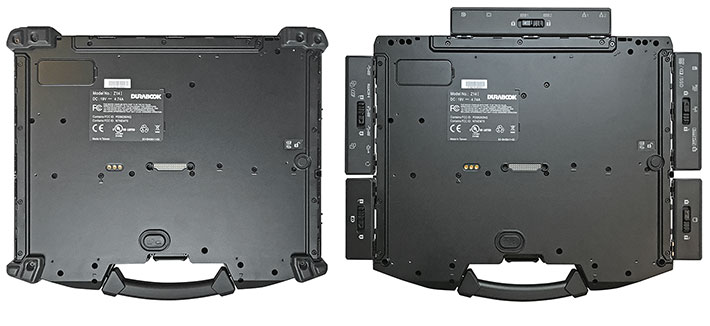
So how can you get to the two RAM memory slots and the other expansions lots? That's not immediately obvious. They are located underneath the keyboard and to access them you first have to flip open the keyboard. That requires taking off the plastic hinge and function button cover, then carefully prying the keyboard loose and removing the screws that hold the two module compartment covers in place. Keep track of the two keyboard ribbon cables that must be firmly seated in their respective connectors.
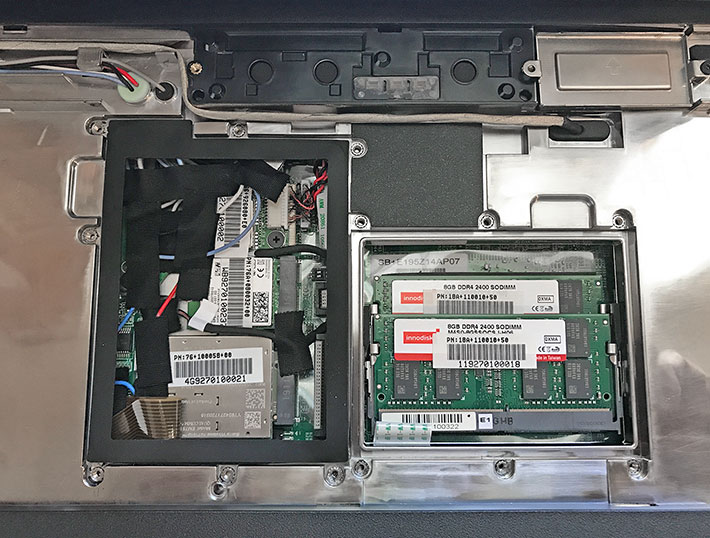
We generally open up all review units that pass through the RuggedPCReview.com test lab. That's because ruggedness starts inside. A good rugged unit is built rugged from the ground up. With most laptops, the bottom of the unit comes off and affords a full look at at the insides. The DURABOOK Z14I's designers, however, took a dfferent approach, one where all electronics sit in the strong system box and it is the keyboard side that comes off.
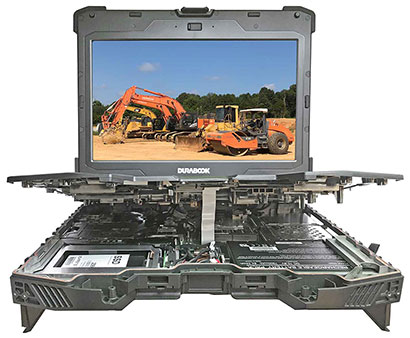 This type of the design actually makes a lot of sense as it provides a structurally very strong basis, in essence a box with a top that comes off. The drawback when opening up the unit is that there are usually ribbon and other cables between the electronics and the keyboard top of the unit. This type of the design actually makes a lot of sense as it provides a structurally very strong basis, in essence a box with a top that comes off. The drawback when opening up the unit is that there are usually ribbon and other cables between the electronics and the keyboard top of the unit.
We decided to try anyway and undid the fairly large number of screws that hold the big, tough Z14I together.
However, we chose not to separate all the cables on top and fully separate the halves. Instead, we opened the clamshell just enough to take a good peek inside. The seal between the bottom cage and the polymer plastic top is via a tongue-and-groove design with a replaceable orange seal.
We also got a glimpse of the copper tubing that syphons heat off the processor and ancillary electronics and disseminates it into the thick and heavy aluminum-magnesium bottom of the laptop. This works remarkably well; even without a cooling fan, the big DURABOOK barely heated up.
Most laptop users are used to fans as a necessary nuisance, but it is so nice not to have a noisy fan that blows hot air.
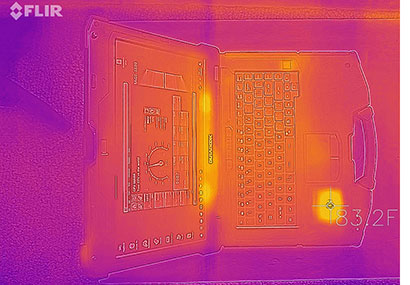 The picture on the left was taken with our FLIR One Pro infrared camera while the Z14I was running a benchmark. The bright yellow areas is where the DURABOOK heated up most. Even in the CPU area we recorded just over 80F. Amazing how much heat a heavy metal chassis can soak up, spread, and disseminate. Keeping temperatures low has a direct impact on overall systems performance. That's because maximum achievable processor "turbo" clock speeds depend on temperature readings. The picture on the left was taken with our FLIR One Pro infrared camera while the Z14I was running a benchmark. The bright yellow areas is where the DURABOOK heated up most. Even in the CPU area we recorded just over 80F. Amazing how much heat a heavy metal chassis can soak up, spread, and disseminate. Keeping temperatures low has a direct impact on overall systems performance. That's because maximum achievable processor "turbo" clock speeds depend on temperature readings.
Also interesting is the Z14I's internal construction with numerous daughterboards providing services to the mother board. This type of design provides room for customization, easy replacement of modules, and easy tech updates.
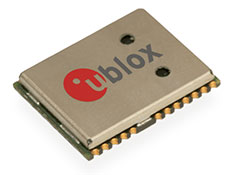 Our review unit came with a ublox NEO-M8N concurrent GNSS module. A great feature of the M8N is that it can track up to three of the four available GNSS systems concurrently, those being GPS (the US system), GLONASS (the Russian version of GPS), the European Galileo, and the Chinese BeiDou. The ability to track three of those systems means potentially triple the number of available satellites, making for quick starts, very good accuracy, and superior coverage. Our review unit came with a ublox NEO-M8N concurrent GNSS module. A great feature of the M8N is that it can track up to three of the four available GNSS systems concurrently, those being GPS (the US system), GLONASS (the Russian version of GPS), the European Galileo, and the Chinese BeiDou. The ability to track three of those systems means potentially triple the number of available satellites, making for quick starts, very good accuracy, and superior coverage.
The DURABOOK Z14I has two SODIMM RAM slots. Our review machine came with two 8GB DDR4 Innodisk sticks. The two PCIe M.2 expansion sockets of our tester were used for WiFi (an Intel Dual Band Wireless AC 9260 802.11a/b/g/n/ac with Bluetooth 5.0 in our unit) and optional WWAN (ours had a Sierra Wireless AirPrime MC7355). Both have prewired antenna leads.
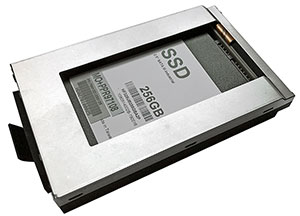 Mass storage is located inside a black plastic box with a metal cover that fits flush into the left side of the unit. The basic standard configuration of the DURABOOK Z14I comes with a SATA III 256GB SSD but Durabook still offers hard disks for DURABOOK Z14I.
Mass storage is located inside a black plastic box with a metal cover that fits flush into the left side of the unit. The basic standard configuration of the DURABOOK Z14I comes with a SATA III 256GB SSD but Durabook still offers hard disks for DURABOOK Z14I.
This may well be the last time we see room for a 2.5-inch rotating disk in a new design. The move to smaller and much more robust solid state disks is too compelling. And for performance reason's we hope Durabook will soon make PCIe-based mass storage available.
As is, the mass storage caddy is designed to quickly be removed from the laptop. That is often a requirement in enterprise and government settings. The caddy is locked and unlocked via a friction lever. It is not likely to come lose unintentionally.
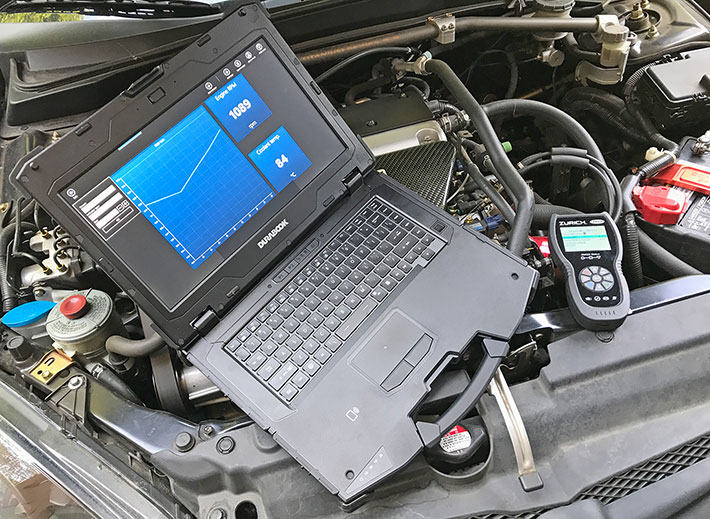
Keyboard and touch pad — pleasant
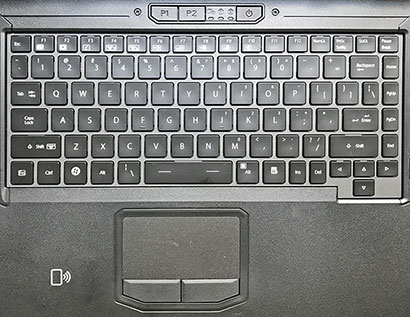 The DURABOOK Z14I's keyboard is full-scale and has 88 keys. The key design is standard "island" style with flat keys and minimal travel but good tactile feedback, as is common in today's notebooks and even desktop keyboards. The DURABOOK Z14I's keyboard is full-scale and has 88 keys. The key design is standard "island" style with flat keys and minimal travel but good tactile feedback, as is common in today's notebooks and even desktop keyboards.
The central QWERTY layout is 100%-scale, which means the distance between the center of the Q key on the left and the P key on the right is 6.75 inches. That makes it perfect for touch typists. The keys are black with white letters, numbers and symbols. Optionally available is an LED keyboard backlight with brightness adjusted via function keys.
Below the keyboard is the unit's capacitive touch pad. It is a properly sized (not too small, not too large) touch area with a slight frame around it so your fingers feel the extent of the pad, and with two large mouse buttons in front of it. The mouse buttons require a relatively firm press and issue an audible mechanical click. The touch pad is very responsive and easy to use, and it can even be operated with gloves on (as long as they are not too thick).
Above the keyboard are two programmable function buttons, three status indicator lights (disk activity, numlock, capslock), and then power/sleep button.
Performance — excellent
Although somewhat reminiscent in design to the semi-rugged S14I, the DURABOOK Z14I seems an entirely new design. Not being held back by legacy tech gave the company a chance to match or beat the formidable fully-rugged laptop competition in features and performance. Tech is, of course, a moving traget and state-of-the-art is never more than an upgrade or a new generation of Intel processors away.
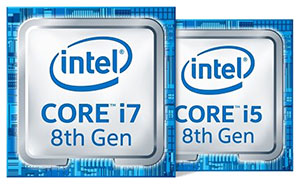 As of this writing (October 2018), the DURABOOK Z14I is right there at the forefront. Of the fully-rugged laptop competition in this size class, the Panasonic Toughbook 31 is still at the 7th generation of Intel Core processors. The Getac B300 was recently upgraded to the same four 8th generation processors that are available with the Z14I. Dell also offers 8th generation in its Latitude 7424 Rugged Laptop. As of this writing (October 2018), the DURABOOK Z14I is right there at the forefront. Of the fully-rugged laptop competition in this size class, the Panasonic Toughbook 31 is still at the 7th generation of Intel Core processors. The Getac B300 was recently upgraded to the same four 8th generation processors that are available with the Z14I. Dell also offers 8th generation in its Latitude 7424 Rugged Laptop.
So we pretty much have processor parity. That means substantial processing power, but also no support for Windows 7 (the last Intel generation that supported Windows 7 was 6th gen "Skylake) which according to the Net Marketshare site still ran on over 1/3 of all desktops and laptops as of Fall 2019.
What is Intel's 8th generation of Core Processors all about and how is it better than the prior generations? Well, while Intel modestly code-named their 8th generation Kaby Lake Refresh, for mobile users it really is much more than that. That's because, for the first time, the ultra-low voltage (i.e. 15 watt) mobile processor lineup is quad-core, octa-thread.
While, on the surface, there haven't been drastic changes between 6th, 7th and 8th generation Core processors (same core architecture, still 14nm process technology), Intel's optimizing, fine-tuning and improvements between these generations resulted in markedly better performance and higher efficiency.
|
DURABOOK Z14I: Processor options
|
|
PROCESSOR OPTIONS
|
Core i7
|
Core i7
|
Core i5
|
Core i5
|
|
Model
|
8650U
|
8550U
|
8350U
|
8250U
|
|
Gen
|
8th
|
8th
|
8th
|
8th
|
|
Cores/Threads
|
4/8
|
4/8
|
4/8
|
4/8
|
|
Base Clock Speed
|
1.90 GHz
|
1.80 GHz
|
1.70 GHz
|
1.60 GHz
|
|
Turbo Speed
|
4.20 GHz
|
4.00 GHz
|
3.60 GHz
|
3.40 GHz
|
|
Cache
|
8MB SmartCache
|
8MB SmartCache
|
6MB SmartCache
|
6MB SmartCache
|
|
Thermal Design Power (TDP)
|
15 watts
|
15 watts
|
15 watts
|
15 watts
|
|
Smart Cache
|
8MB
|
8MB
|
6MB
|
6MB
|
|
Graphics base speed
|
300 MHz
|
300 MHz
|
300 MHz
|
300 MHz
|
|
Graphics max speed
|
1.15 GHz
|
1.15 GHz
|
1.10 GHz
|
1.10 GHz
|
|
Intel vPro
|
Yes
|
No
|
Yes
|
No
|
|
Intel TSX-NI
|
Yes
|
No
|
Yes
|
No
|
|
Intel SIPP
|
Yes
|
Unknown
|
Yes
|
No
|
|
Intel Trusted Execution
|
Yes
|
Yes
|
Yes
|
No
|
Graphics cores, especially, are much improved, with better 4K video capability in Kaby Lake and Kaby Lake Refresh. A new implementation of Speed Shift lets the CPU control turbo frequency instead of the operating system, which means the chip could speed up much faster.
The biggest advance, in our opinion, is the switch from dual to quad core processors. That's accompanied by a fairly substantial reduction of base clock speed and an increase in maximum turbo speed. The idea here is relaxed idling along while doing routine jobs, conserving power. If high loads come along, all four cores kick in at turbo speeds, for maximum performance.
The top processor option for the DURABOOK Z14I is the Intel Core i7-8650U. This high-end chip offers higher base and turbo clock speeds, slightly faster graphics clock speed, and 8MB instead of 6MB Intel SmartCache. Next in line is the Core i7-8550U, a slightly slower i7 processor without the vPro technology and some other baked in Intel goodies.
Then comes the Core i5-8350U, a bit slower again and with less smart cache, but it still has all the same Intel technologies built in as the i7-8650U, including vPro. At the low end there's the Core I5-8250U, the slowest of the quartet, and not including four of the Intel technologies included in the top two chips. All four, however, are quad-core/octa-thread. To view the full spec table for these four quad-core CPUs, see here.
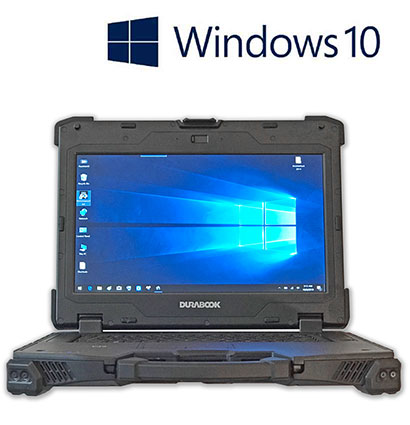 What may make a difference in certain applications is the availability of four special Intel technologies (vPro, TSX-NI, SIPP, and Trusted Execution) included in the i7-8650U and i5-8350U, but not in the i7-8550U and i5-8250U. Here's what that means:
What may make a difference in certain applications is the availability of four special Intel technologies (vPro, TSX-NI, SIPP, and Trusted Execution) included in the i7-8650U and i5-8350U, but not in the i7-8550U and i5-8250U. Here's what that means:
- The extra security and manageability capabilities of vPro, especially, are required in many enterprise deployments.
- TSX-NI (Transactional Synchronization Extensions New Instructions) helps make parallel operations more efficient via improved control of locks in software,
- SIPP (Stable Image Platform Program) allows deployment of standardized, stable image PC platforms for at least 15 months, and
- Trusted Execution technology provides security capabilities such as measured launch and protected execution, and may thus also be an enterprise requirement.
To see what kind of performance the new quad-core DURABOOK Z14I can achieve, we ran our standard benchmark suites, Passmark Software's PerformanceTest version 6.1 and the latest version 9.0. Both include dozens of tests covering CPU, 2D graphics, 3D graphics, memory, and disk and then compute scores for each category and an overall PassMark score. We also ran CrystalMark, an older benchmark suite that provides insight into single core performance.
For comparison and to provide an idea where the new Z14I stands in Durabook' rugged and semi-rugged laptop lineup, we included benchmark results of the DURABOOK S14I we tested earlier in 2019, the fairly recent third gen DURABOOK SA14, the larger DURABOOK S15AB, and the DURABOOK U11 tablet/2-in-1.
The results are as follows:
|
DURABOOK Z14I Benchmarks and Comparisons
|
|
PERFORMANCE COMPARISON
|
DURABOOK
|
DURABOOK
|
DURABOOK
|
DURABOOK
|
DURABOOK
|
|
Model
|
Z14I
|
S14I
|
SA14
|
S15AB
|
U11
|
|
Year tested
|
2019
|
2019
|
2017
|
2016
|
2018
|
|
Processor Type: Intel
|
Core i7
|
Core i5
|
Core i7
|
Core i5
|
Core i7
|
|
Processor Model
|
8550U
|
8250U
|
7500U
|
5200U
|
7Y75
|
|
Cores/threads
|
4/8
|
4/8
|
2/4
|
2/4
|
2/4
|
|
CPU Speed
|
1.80 GHz
|
1.60 GHz
|
2.70 GHz
|
2.20 GHz
|
1.30 GHz
|
|
Turbo Speed
|
4.00 GHz
|
3.40 GHz
|
3.50 GHz
|
2.70 GHz
|
3.60 GHz
|
|
Thermal Design Power (TDP)
|
15 watts
|
15 watts
|
15 watts
|
15 watts
|
4.5 watts
|
|
CPU Mark 6.1
|
9,153.2
|
6,850.6
|
5,984.5
|
3,536.7
|
3,775.3
|
|
2D Graphics Mark 6.1
|
366.0
|
305.4
|
400.7
|
518.4
|
280.1
|
|
Memory Mark 6.1
|
2,343.3
|
1,843.3
|
3,846.4
|
1,430.4
|
1,720.6
|
|
Disk Mark 6.1
|
5,002.6
|
4,951.9
|
3,893.9
|
3,655.5
|
3,997.0
|
|
3D Graphics Mark 6.1
|
877.7
|
425.5
|
891.1
|
462.8
|
367.0
|
|
Overall PassMark 6.1
|
4,050.2
|
3,265.7
|
2,449.9
|
2,071.6
|
2,211.7
|
|
CPU Mark 9.0
|
9,405.7
|
6,839.9
|
NA
|
NA
|
3,615.6
|
|
2D Graphics Mark 9.0
|
795.6
|
498.7
|
NA
|
NA
|
447.8
|
|
Memory Mark 9.0
|
2,987.3
|
2,240.7
|
NA
|
NA
|
2,109.1
|
|
Disk Mark 9.0
|
4,752.6
|
4,736.3
|
NA
|
NA
|
3,826.2
|
|
3D Graphics Mark 9.0
|
1,364.6
|
872.7
|
NA
|
NA
|
691.5
|
|
Overall PassMark 9.0
|
3,935.8
|
2,726.5
|
NA
|
NA
|
2,084.1
|
|
CM ALU
|
77,272
|
59,613
|
55,408
|
41,280
|
39,309
|
|
CM FPU
|
58,981
|
53,477
|
55,119
|
37,524
|
32,013
|
|
CM MEM
|
86,477
|
49,102
|
70,536
|
44,983
|
34,472
|
|
CM HDD
|
47,246
|
43,671
|
38,827
|
40,383
|
39,733
|
|
CM GDI
|
22,376
|
14,814
|
20,393
|
17,033
|
10,797
|
|
CM D2D
|
7,973
|
4,580
|
6,989
|
6,735
|
4,431
|
|
CM OGL
|
12,850
|
8,544
|
16,474
|
8,184
|
7,464
|
|
Overall CrystalMark
|
313,175
|
233,801
|
264,046
|
231,170
|
192,170
|
What can we learn from these numbers? Are four cores twice as good as two? Does having four cores instead of two make up for the much lower standard clock speed compared to earlier dual-core generations? And how about the graphics? Are they faster, too? The answer to these questions, and others, is a solid "it depends."
As is, the Z14I with the 8th generation Intel Core processor did, as one would expect from a brand-new design with state-of-the-art technology, bring home the highest overall PassMark score. It easily bested the Core i5 8250U-equipped DURABOOK S14I we reviewed in February 2019. Overall it's clear that when it comes to Intel Core processors, four cores with a low standard clock speed outperform two cores with a higher standard clock speed.
That said, it all depends on the software. If an app doesn't contains a lot of code that can run concurrently, more cores won't make processing faster. If an app is highly multi-threaded, then it will be much faster with a higher number of cores.
Disk benchmark performance wasn't exceptional compared to other recent DURABOOKs we tested, and we know why. While all of them have left behind comparatively slow rotating hard disk behind in favor of much faster SSDs (Solid State Disks), DURABOOKs still use the older SATA interface protocol that was developed for rotating hard disks. A switch to PCIe NVMe-based SSDs would considerably boost overall performance. With processor parity amongst the leading rugged laptops, PCIe NVMe mass storage offers an inexpensive competitive edge.
On the graphics side, the Intel UHD Graphics 620 integrated in all processors available for the Z14I are quick enough, but users with graphics-intensive applications should probably go for the optional NVIDIA discrete graphics that the company offered for the the S14I and probably also offers for the Z14I.
Finally, note that our test machine came with the Core i7-8550U processor option available for the Z14I. Machines equipped with the top-of-the-line Core i7-8500U may see an estimated roughly 5% performance bump in CPU performance.
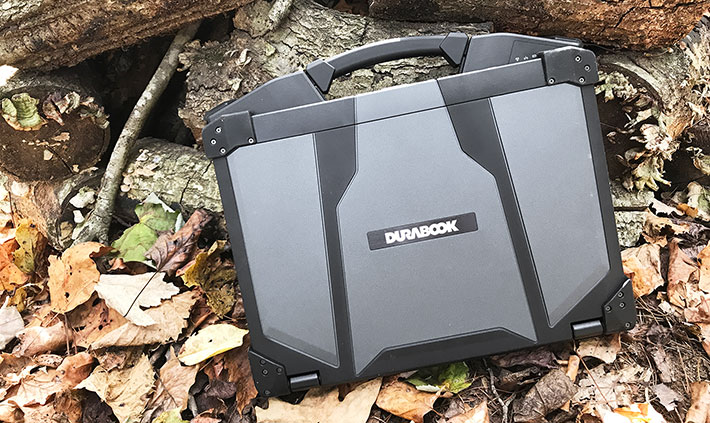
Power draw and battery life
It is one of the frustrations of modern life that mobile technology — the very tech that needs to be as small and light as possible — is also the tech that needs a battery that lasts as long as possible between charges. The proper sizing of laptop batteries, especially, is an exercise of give and take. A big battery makes for impressive battery life, but it comes at the cost of extra size and weight.
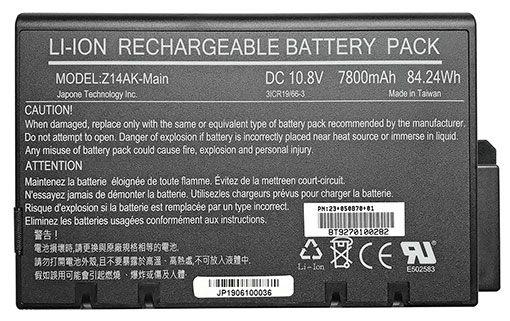 Weight, of course, matters with fully-ruggeds as it does with any other mobile computer, but not quite as much. This class of laptops usually weighs 7-9 pounds, and a bit more or less doesn't make that much of a difference. So with the Z14I, Durabook went with a big 84 watt-hour battery that weighs a pound all by itself.
Weight, of course, matters with fully-ruggeds as it does with any other mobile computer, but not quite as much. This class of laptops usually weighs 7-9 pounds, and a bit more or less doesn't make that much of a difference. So with the Z14I, Durabook went with a big 84 watt-hour battery that weighs a pound all by itself.
And if that's not enough, there's an optional smaller secondary battery rated at 51 watt-hours. That goes into the expansion/media bay (in lieu of an optical drive or secondary storage) and brings combined battery capacity up to an impressive 135 watt-hours.
How long does the DURABOOK Z14I last on a charge of its primary battery? Is the optional second battery needed/advisable? As is our standard procedure, we used Passmark Software's BatteryMon power management benchmark utility to measure the laptop's power draw under various operating conditions.
First we set the Windows 10 power options to "Max Battery" and display brightness to its lowest setting. That way we saw an idle power draw of 6.3 watts. We then cranked the backlight up to 50%, and draw increased to 7.4 watts. Then we cranked brightness all the way up to 100% and saw 10.5 watts.
|
DURABOOK Z14I Power Draws (at idle)
|
|
Backlight level
|
Darkest
|
50%
|
Brightest
|
|
Max Battery
|
6.3 watts (13.3 hrs.)
|
7.4 watts (11.4 hrs.)
|
10.5 watts (8.0 hrs.)
|
|
Max Performance
|
6.6 watts (12.7 hrs.)
|
8.6 watts (9.8 hrs.)
|
18.2 watts (4.6 hrs.)
|
We then set the tablet to "Max Performance." At the lowest brightness setting we saw an idle power draw of 6.6 watts. At 50% brightness draw increased to 8.6 watts. And at the maximum standard brightness setting, electric draw reached 18.2 watts. Why such a big difference between the max battery and max performance settings? It's because maximum brightness in the max performance setting is considerably brighter than maxim brightness in the max battery setting.
What do those power draw figures mean in terms of projected battery life? Equipped with both just the standard battery, our review Z14I had a battery capacity of 84 watt-hours. Dividing that by the 6.3 watt minimum observed draw would indicate 13.3 hours of theoretical battery life with the system staying awake the whole time. In the maximum performance settings and the very bright maximum brightness, theoretical battery life would drop all the way to 4.6 hours.
Durabook's own estimate is 15 hours with the standard battery. That's quite possible (we didn't turn off all the radios in our max battery scenario, for example). But unless an optical drive or secondary mass storage is needed, we'd probably consider springing for the secondary 51 watt-hour battery. It only adds about 10 ounces of weight, but several hours more running time.

Display — very bright and great reflection control
The DURABOOK Z14I's display measures 14 inches diagonally, which is standard for this type of laptop. Its 1920 x 1080 pixel resolution is much more pleasant to work with than the marginal 1366 x 768 that used to be the norm for semi-ruggeds. 1920 x 1080 resolution makes for 157 pixels per inch, not high by smartphone or tablet standards, but well matched for Windows 10 on a laptop. 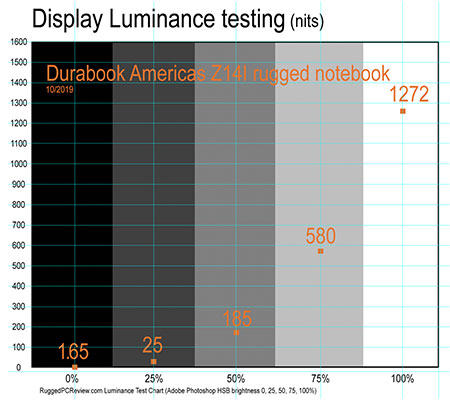
Whereas bright, outdoor-viewable displays are usually optional in semi-ruggeds, the fully-rugged Z14I comes standard with a brilliant display that's rated at 1,000 nits luminance. What's more, there are easily accessible stealth and night vision modes that may be required by some customers and agencies.
And since it may rain our there in the field, or it's cold and users wear gloves, the optional 10-point capacitive multi-touch Z14I display our review unit came with can be switched to finger/water, glove, or stylus only modes, or touch can be turned off altogether.
DURABOOK displays tend to exceed their stated nits ratings, and the Z14I's is no different. We used RuggedPCReview's luminance testing equipment and our custom luminance chart to see how bright the Z14I actually is. The test chart shows grayscale bands from 0% to 100% coverage in 25% increments.
As the image to the right shows, with a maximum recording of 1,272 nits the Z14I display significantly outperformed its 1,000 nits rating. Impressive.
The screen isn't just bright and vibrant and easily suitable for all all outdoor use; its surface is semi-matte, eliminating most of the annoying reflections common to most of today's consumer notebooks, and there seems to be a degree of anti-glare applied to it. Both horizontal and vertical viewing angles are near perfect. There are no color shifts, no contrast shifts, and none of the brightness degradation that plagues some screens when viewed from the side.
The picture below shows the Z14I outdoors on an average October day around noon. The display backlight wasn't even set to full brightness. The screen looks bright, vibrant and perfectly readable.
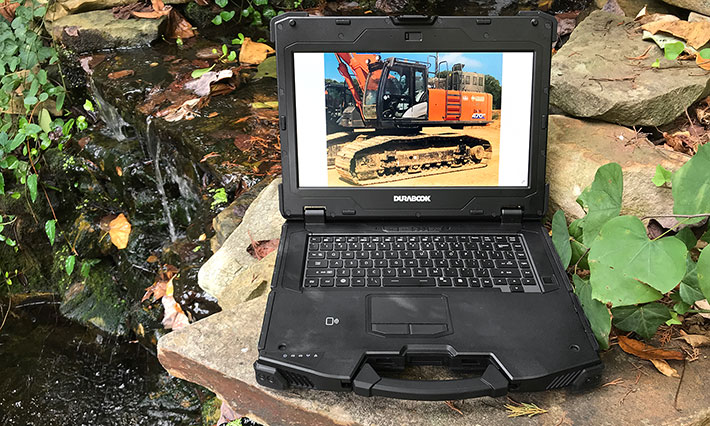
The images below shows the DURABOOK Z14I in typical light influx scenarios. The semi-matte display of the Z14I does not reflect; instead, it diffuses direct light and that results in the milkiness shown in one of the pictures below.
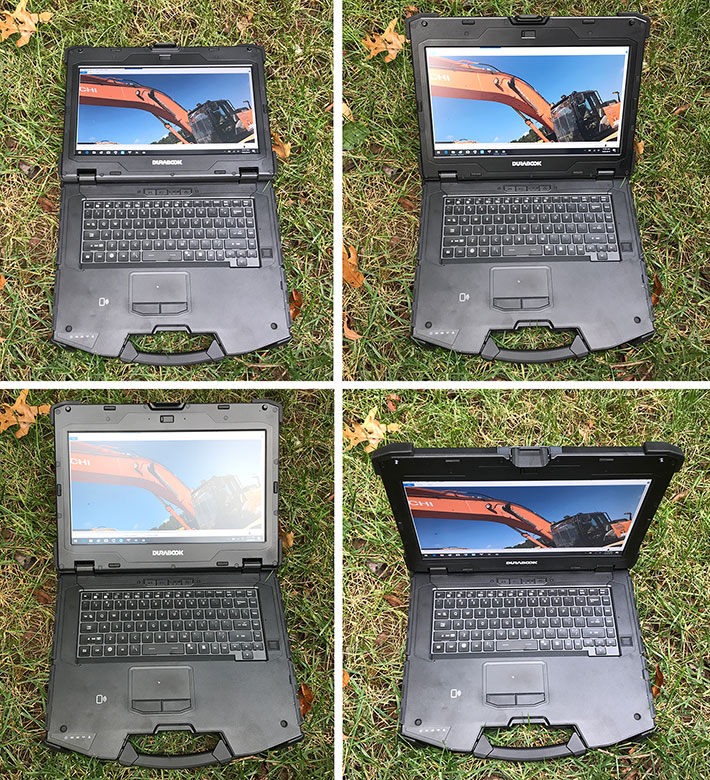
Overall, the DURABOOK Z14I display is very good. It is very bright and contrasty indoors, and it remains very readable even in strong sunlight. Unlike the displays on many older DURABOOKs, the Z14I's IPS display features perfect viewing angles from all directions, a big plus. Likewise, users will appreciate the full HD 1920 x 1080 pixel resolution of the default display.
Fully-rugged
With the DURABOOK Z14I, as far as we can tell, Durabook had two goals. One was to give the existing DURABOOK R8300 a new running mate with contemporary design, functionality, and features. The other was to meet or beat the fully-rugged laptop competition from Dell, Getac and Panasonic with a brand-new machine.
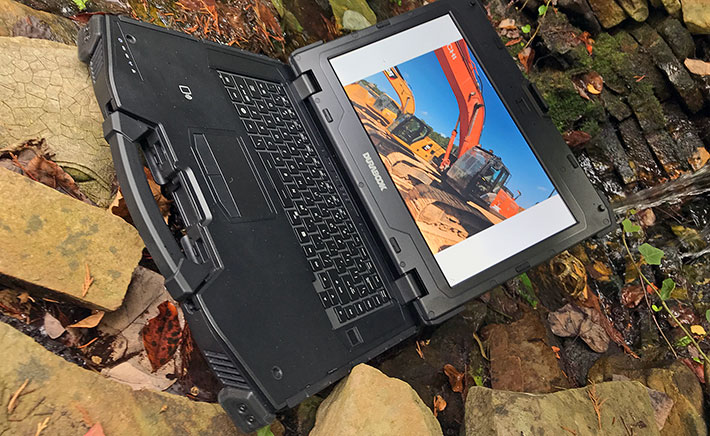
While ruggedness metrics include a variety of tests, two stand out. What kind of a drop can a laptop survive? And how well is it protected against wetness and particulates. The former is measured in feet and testing is performed according to MIL-STD-810G (and now MILD-STD-810H)n procedures. The latter is expressed in an IP Ingress Protection) rating.
What Durabook did with the DURABOOK Z14I is build it so it can handle 6-foot drops and get an IP65 rating. That's way tougher than semi-ruggeds, and with it the DURABOOK Z14I can now meet the major competition head-on.
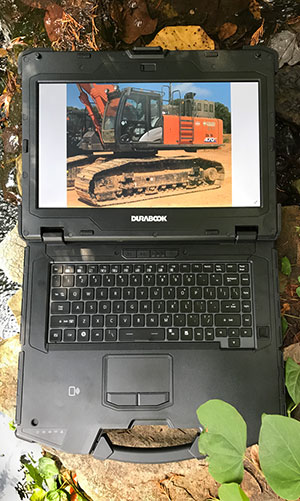 The relevance of the 6-foot drop versus the 4-foot drop mandated by the government Department of Defense standard and the 3-foot drop semi-ruggeds can usually handle is illustrated in the pictures above: when you walk around with a notebook under your arm and you drop it, that's about three feet.
The relevance of the 6-foot drop versus the 4-foot drop mandated by the government Department of Defense standard and the 3-foot drop semi-ruggeds can usually handle is illustrated in the pictures above: when you walk around with a notebook under your arm and you drop it, that's about three feet.
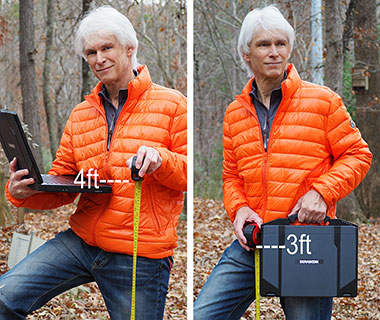 But when you drop it while using it — which almost inevitably happens at some point — that's four feet. Should what is likely to happen be the very limit? No, it's better to have a margin of error. Hence Durabook's insistence on being able to handle six foot drops. But when you drop it while using it — which almost inevitably happens at some point — that's four feet. Should what is likely to happen be the very limit? No, it's better to have a margin of error. Hence Durabook's insistence on being able to handle six foot drops.
On the sealing front, Durabook claims IP65-level protection for the Z14I. The "6" means complete protection against dust, and the "5" means protection against low pressure water spray spray from all directions. Rain won't even be an issue.
As for the operating temperature range, the Z14I specs claims an impressive -4°F to 140°F (-20°C to 60°C), which means the laptop can be used virtually anywhere.
According to Durabook, the Z14I has been MIL-STD-810G certified for drop, shock, vibration, rain, dust, altitude, freeze/thaw, high/low temperature, temperature shock, humidity, explosive atmosphere, solar radiation, salt fog, and fungus resistance. It also has been MIL-STD-461G certified for conduction, radiation, conducted susceptibility, and radiated susceptibility. We'd like to see these certifications published on the Durabook website so that prospective customers can see the exact testing parameters.
Summary: The DURABOOK Z14I fully-rugged laptop
With the Z14I fully-rugged laptop, Durabook now has a thoroughly modern tool for customers who require high-performance computing power out there in the field, in vehicles, on the shop floor, or wherever else a tablet or a handheld or even a semi-rugged laptop just won't do. It's an attractive, impressive machine with a very bright, reflection-free 14-inch wide-format display, good connectivity, good battery life, and excellent performance.
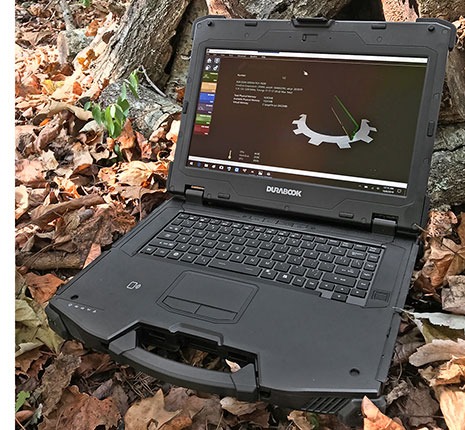 In terms of ruggedness, the fanless DURABOOK Z14I meets or exceeds fully-rugged class standards. The laptop's 6-foot drop spec provides a good safety cushion past most common drop scenarios, and its IP65 ingress protection rating means it can handle anything short of full immersion. In terms of ruggedness, the fanless DURABOOK Z14I meets or exceeds fully-rugged class standards. The laptop's 6-foot drop spec provides a good safety cushion past most common drop scenarios, and its IP65 ingress protection rating means it can handle anything short of full immersion.
The official US$3,599 starting price of the DURABOOK Z14I is significantly higher than that of the company's semi-rugged laptops, but in line or below that of the fully-rugged competition. Note that DURABOOK computers are built-to-order and available in a wide range of configurations and the choice of many options that can drive up the price.
DURABOOK laptops have always been strong performers, and that tradition carries on with the Z14I. Available with a choice of four quad-core Intel 8th generation Core processors, the laptop scored excellent overall benchmark results. Equipped with the standard battery, our review machine scored over 13 hours in our battery test. An optional secondary battery is available.
The DURABOOK Z14I has an excellent 1920 x 1080 pixel wide-format 1,000 nits (we measured 1,270 nits) IPS display that controls reflection and glare well. Our review unit came with the optional capacitive multi-touch screen.
Designed for the extreme conditions faced by military, industry, field service personnel, and similar demanding deployments, the DURABOOK Z14I, with its aluminum-magnesium alloy chassis and bottom, large protective bumpers, and exceptionally solid construction should hold up for a long time.
With the DURABOOK Z14I, Durabook has a strong and very competitive offering in the hotly contested market of fully-rugged laptops. — Conrad H. Blickenstorfer, October 2019
 DURABOOK Z14I Specifications DURABOOK Z14I Specifications
|
| Status |
Full review 10/2019
|
| Product type |
Fully-rugged notebook computer
|
| Processor |
Intel 8th Gen (Kaby Lake Refresh) Core i7-8650U
Intel 8th Gen (Kaby Lake Refresh) Core i5-8550U
Intel 8th Gen (Kaby Lake Refresh) Core i5-8350U
Intel 8th Gen (Kaby Lake Refresh) Core i5-8250U
|
| CPU speed |
Core i7-8650U: 1.90GHz (max Turbo Boost speed 4.20Ghz)
Core i7-8550U: 1.80GHz (max Turbo Boost speed 4.00Ghz)
Core i5-8350U: 1.70GHz (max Turbo Boost speed 3.60Ghz)
Core i5-8250U: 1.60GHz (max Turbo Boost speed 3.40Ghz)
|
| CPU Thermal Design Power |
All 15 watts
|
| OS |
Windows 10 Professional
|
| Graphics |
Intel UHD Graphics 620, optional NVIDIA GeForce GTX 1050 MXM
|
| Memory |
8GB to 32GB DDR4-2400MHz in two 204-pin SODIMM sockets |
| Display type |
Transmissive TFT with anti-glare coating and 10-step adjustable backlight OR optional 1,000-nits (1270 nits as tested) sunlight-readable with touch screen and Night Vision mode
|
| Display size and resolution |
14.0"/1920 x 1080 pixel (157 ppi) FHD
|
| Digitizer/Pens |
10-finger capacitive multi-touch
|
| Keyboard |
Waterproof 88-key membrane keyboard, optional LED backlight
|
| Storage |
500GB or 1TB SATA hard disk or 256GB to 1TB Solid State Disk user removable storage; OPAL2.0 SSD available, FIPS-140-2 SSD (test unit had 2-1/2-inch SATA3 6Gb/s 256GB Micron MTFDDAK256TBN) |
| Multimedia Pocket |
Super Multi DVD-RW Drive OR 2nd Battery Pack OR 2nd storage (SSD)
|
| Slots |
1 x microSDXC Card, 1 x SIM card, 1 x SmartCard reader, 1 x ExpressCard 54 OR 1 x PCMCIA Type II
|
| Housing |
Aluminum-magnesium chassis with port covers |
| Temperature |
-4° to 140°F (-20° to +60°C)
est: |
| Humidity |
5 to 95% non-condensing |
| Vibration |
MIL-STD-810G tested
|
| Ingress protection |
IP65 |
| Explosive Atmosphere |
NA |
| EMI |
NA |
| Shock: Functional |
MIL-STD-810G tested
|
| Shock: Transit Drop |
MIL-STD-810G, Method 516.6, Procedure IV (26 6-foot drops to plywood over concrete) |
| Certifications |
FCC, DOC+ FCC ID, CE |
| Size (inches) |
14.0 x 11.0 x 2.0 inches (356 x 280 x 50 mm) including carry handle |
| Weight |
7.94 lbs (3.6kg); 8.75 pounds as tested with battery, optical drive, and handle.
|
| Power |
Hot-swappable 6-cell 10.8V, 7,800 mAH 84.2 watt-hour Li-Ion ("15 hrs."), 5-min bridge battery,; optional second 6-cell 10.8V, 4.700 mAH 50.8 watt-hour battery |
| Camera |
Integrated 2-megapixel webcam with privacy shutter
|
| Security |
Intel vPro (per CPU options), TPM 2.0, NIST BIOS compliant, easy removable SSD, Smart Card reader default, Stealth mode, Kensington lock, Night vision mode; optional: fingerprint scanner; RFID reader
|
| Wireless |
Intel Dual Band Wireless-AC 9260, 802.11ac, Bluetooth 5.0; optional: uBlox NEO-M8N GPS, 4G LTE multi-carrier mobile broadband, RF antenna pass-through for GPS, WWAN,
and WLAN
|
| Interface |
2 x USB 3.1 Type-A, 1 x USB 3.1 Type-C, 1 x USB 2.0 Type-A, 2 x RJ45, 1 x DB9 RS232 serial , 1 x VGA, 1 x HDMI Type-A, 2 x RS232, audio in/out, dock
|
| Price |
Starting MSRP US$3,599 |
| Contact |
Durabook
|
| Website |
DURABOOK Z14I page |
| Brochure |
 DURABOOK Z14I brochure DURABOOK Z14I brochure |
| Warranty |
3-Year DURABOOK 3-D warranty |
| Contact |
Durabook, 48329 Fremont Blvd., Fremont, CA 94538, 510-492-0828 |
|
|






